Algebra tile
Algebra tiles are mathematical manipulatives that allow students to better understand ways of algebraic thinking and the concepts of algebra. These tiles have proven to provide concrete models for elementary school, middle school, high school, and college-level introductory algebra students. They have also been used to prepare prison inmates for their General Educational Development (GED) tests.[1] Algebra tiles allow both an algebraic and geometric approach to algebraic concepts. They give students another way to solve algebraic problems other than just abstract manipulation.[1] The National Council of Teachers of Mathematics (NCTM) recommends a decreased emphasis on the memorization of the rules of algebra and the symbol manipulation of algebra in their Curriculum and Evaluation Standards for Mathematics. According to the NCTM 1989 standards "[r]elating models to one another builds a better understanding of each".[2]
Physical attributes
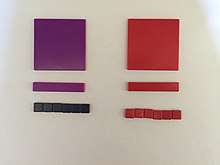
Algebra tiles are made up of small squares, rectangles, and large squares. The small square, the unit tile, represents the 1; the rectangle represents the variable ; and the large square represents . The side of the tile is equal to the length of the tile. The width of the tile is the same as the side of the unit tile. Additionally, the length of the tile is often not an integer multiple of the side of the unit tile.
The tiles consist of two colors: one to show positive values and another to show negative values. A zero pair is a negative and a positive unit tile (or a negative and a positive tile, or a negative and a positive tile) which together form a sum of zero.[1]
Uses
Adding integers
Adding integers is the best place to start when one wants to get used to the idea of representing numbers with a quantity of tiles. Any integer can be represented by using the same number of tiles in the correct color. For example, for a 6 one could select six yellow tiles. For -3 one would select three red tiles. The tiles are usually double sided with yellow on one side and red on the other. This allows the student to grasp the powerful concept of "taking the opposite" of a negative, simply meaning the opposite. So one yellow tile is positive and the opposite (flip it over) is a negative one. This idea comes in handy when dealing with a - (-2). In order to work with a complex situation like this, start with two -1s (red side) and the extra negative means take the opposite or flip them over. - (-2) = 2.
When adding tiles, one should think of combining the quantities together. If one is adding 2 + 3, they are to combine two yellow tiles with three yellow tiles to make 5 yellow tiles. The same idea works for combining negative numbers. If one is to add -3 + -1, they are to combine negative three red tiles with one negative red tile to get negative four red tiles. -3 + -1 = -4.
When one adds positive numbers to negative numbers using algebra tiles, they need to bring in the idea of "elimination" or "zero pairs" every time they add a positive one to a negative one. This is true for any number of tiles, as long as the same quantity and opposite sign eliminate each other (or create a zero pair). For example, if one adds -5 + 7, they will combine five red tiles with seven yellow tiles. One can match the red and yellow tiles up one at a time to eliminate five of the yellow tiles to end up with two yellow tiles and zero red tiles. -5 + 7 = 2.
If one starts with more yellow tiles than red, the answer will be positive. If one starts with more red tiles than yellow, the answer will be negative.
One more example: -5 + 2. Five red tiles are being combines with two yellow tiles. The two yellow tiles will eliminate each other, (or form a zero pair) with two of the red tiles leaving three red tiles behind. -5 + 2 = -3.
Subtracting integers
Algebra tiles can also be used for subtracting integers. A person can take a problem such as and begin with a group of six unit tiles and then take three away to leave the student with three remainiing, so then . Algebra tiles can also be used to solve problems like , which is equivalent to the problem . Being able to relate these two problems and why they result in the same answer is important because it shows that . Another way in which algebra tiles can be used for integer subtraction can be seen through looking at problems where one is to subtract a positive integer from a smaller positive integer, like . Here one would begin with five positive unit tiles and then add zero pairs to the five positive unit tiles until there were eight positive unit tiles. Adding the zero pairs will not change the value of the original five positive unit tiles. The student would then remove the eight positive unit tiles and count the number of negative unit tiles left. This number of negative unit tiles would then be the answer, which would be -3.[3]
Multiplication of integers
Multiplication of integers with algebra tiles is performed through forming a rectangle with the tiles. The length and width of the rectangle would be the two factors and then the total number of tiles in the rectangle would be the answer to the multiplication problem. For instance, in order to determine 3 × 4, one would take three positive unit tiles to represent three rows in the rectangle and then there would be four positive unit tiles to represent the columns in the rectangle. This would lead to having a rectangle with four columns of three positive unit tiles, which represents 3×4. Now, the student may count the number of unit tiles in the rectangle, which will equal 12.
Modeling and simplifying algebraic expressions
Modeling algebraic expressions with algebra tiles is very similar to modeling addition and subtraction of integers using algebra tiles. In an expression such as one would group five positive x tiles together and then three negative unit tiles together to represent this algebraic expression. Along with modeling these expressions, algebra tiles can also be used to simplify algebraic expressions. For instance, if one has they can combine the positive and negative x tiles and unit tiles to form zero pairs to leave the student with the expression . Since the tiles are laid out right in front of the student, it is easy to combine the like terms, or the terms that represent the same type of tile.[3]
The distributive property is modeled through the algebra tiles by demonstrating that a(b+c)=(a×b)+(a×c). One would want to model what is being represented on both sides of the equation separately and determine that they are both equal to each other. If one wants to show that then they would make three sets of one unit tile and one x tile and then combine them together to see if it results in , which it does.[4]
Solving linear equations using addition
The linear equation can be modeled with one positive tile and eight negative unit tiles on the left side of a piece of paper and six positive unit tiles on the right side. To maintain equality of the sides, each action must be performed on both sides.[1] For example, eight positive unit tiles can be added to both sides.[1] Zero pairs of unit tiles are removed from the left side, leaving one positive tile. The right side has 14 positive unit tiles, so .
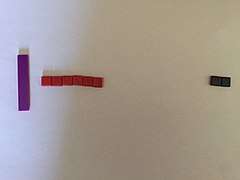 Algebra tile model of
Algebra tile model of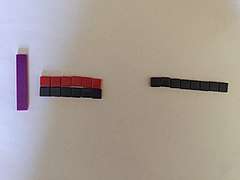 Algebra tile model of
Algebra tile model of Algebra tile model of
Algebra tile model of
Solving linear equations using subtraction
The equation can be modeled with one positive tile and seven positive unit tiles on the left side and 10 positive unit tiles on the right side. Rather than adding the same number of tiles to both sides, the same number of tiles can be subtracted from both sides. For example, seven positive unit tiles can be removed from both sides. This leaves one positive tile on the left side and three positive unit tiles on the right side, so .[1]
 Algebra tile model of
Algebra tile model of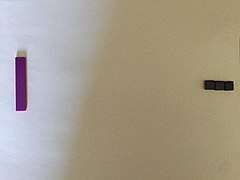 Algebra tile model of
Algebra tile model of
Solving linear systems
Linear systems of equations may be solved algebraically by isolating one of the variables and then performing a substitution. Isolating a variable can be modeled with algebra tiles in a manner similar to solving linear equations (above), and substitution can be modeled with algebra tiles by replacing tiles with other tiles.
Multiplying polynomials
When using algebra tiles to multiply a monomial by a monomial, the student must first set up a rectangle where the length of the rectangle is the one monomial and then the width of the rectangle is the other monomial, similar to when one multiplies integers using algebra tiles. Once the sides of the rectangle are represented by the algebra tiles, one would then try to figure out which algebra tiles would fill in the rectangle. For instance, if one had x×x, the only algebra tile that would complete the rectangle would be x2, which is the answer.
Multiplication of binomials is similar to multiplication of monomials when using the algebra tiles . Multiplication of binomials can also be thought of as creating a rectangle where the factors are the length and width.[2] As with the monomials, one would set up the sides of the rectangle to be the factors and then fill in the rectangle with the algebra tiles.[2] This method of using algebra tiles to multiply polynomials is known as the area model[5] and it can also be applied to multiplying monomials and binomials with each other. An example of multiplying binomials is (2x+1)×(x+2) and the first step the student would take is set up two positive x tiles and one positive unit tile to represent the length of a rectangle and then one would take one positive x tile and two positive unit tiles to represent the width. These two lines of tiles would create a space that looks like a rectangle which can be filled in with certain tiles. In the case of this example the rectangle would be composed of two positive x2 tiles, five positive x tiles, and two positive unit tiles. So the solution is 2x2+5x+2.
Factoring
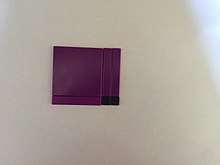
In order to factor using algebra tiles, one has to start out with a set of tiles that the student combines into a rectangle, this may require the use of adding zero pairs in order to make the rectangular shape. An example would be where one is given one positive x2 tile, three positive x tiles, and two positive unit tiles. The student forms the rectangle by having the x2 tile in the upper right corner, then one has two x tiles on the right side of the x2 tile, one x tile underneath the x2 tile, and two unit tiles are in the bottom right corner. By placing the algebra tiles to the sides of this rectangle we can determine that we need one positive x tile and one positive unit tile for the length and then one positive x tile and two positive unit tiles for the width. This means that the two factors are and .[1] In a sense this is the reverse of the procedure for multiplying polynomials.
Completing the square
The process of completing the square can be accomplished using algebra tiles by placing the x2 tiles and x tiles into a square. One will not be able to completely create the square because there will be a smaller square missing from the larger square the student made from the tiles they were given, which will be filled in by the unit tiles. To complete the square, the student would determine how many unit tiles would be needed to fill in the missing square. To complete the square of x2+6x, one would start off with one positive x2 tile and six positive x tiles. Then, they would place the x2 tile in the upper left corner and then one would place three positive x tiles to the right of the x2 tile and three positive unit x tiles under the x2 tile. In order to fill in the square we need nine positive unit tiles. we have now created x2+6x+9, which can be factored into .[6]
References
- Kitt 2000.
- Stein 2000.
- "Prentice Hall School" (PDF). Phschool.com. Archived from the original (PDF) on 2012-02-12. Retrieved 2013-07-22.
- Archived May 16, 2008, at the Wayback Machine
- Larson R: "Algebra 1", page 516. McDougal Littell, 1998.
- Donna Roberts. "Using Algebra Tiles to Complete the Square". Regentsprep.org. Archived from the original on 2013-08-18. Retrieved 2013-07-22.
Sources
- Kitt, Nancy A. and Annette Ricks Leitze. "Using Homemade Algebra Tiles to Develop Algebra and Prealgebra Concepts." MATHEMATICS TEACHER 2000. 462-520.
- Stein, Mary Kay et al., Implementing Standards-Based Mathematics Instruction. New York: Teachers College Press, 2000.
- Larson, Ronald E., Algebra 1. Illinois: McDougal Littell,1998.